

 HOME | ÍNDICE POR TÍTULO | NORMAS PUBLICACIÓN
HOME | ÍNDICE POR TÍTULO | NORMAS PUBLICACIÓN Espacios. Vol. 37 (Nº 27) Año 2016. Pág. 8
Anadalvo Juazeiro dos SANTOS 1; Kauê Augusto Oliveira NASCIMENTO 2; Rodrigo Medeiros RIBEIRO 3; David Alexandre BURATTO 4; Patrícia Maria STASIAK 5
Recibido: 04/05/16 • Aprobado: 23/06/2016
ABSTRACT: The Mixed Rain Forest (MRF) has a wide variety of forest species with high economic value and environmental importance. The non-timber forest products (NTFPs) are presented as a good alternative to the management of this forest type. This study aimed to categorize plant species that compose the MRF for non-timber use. It was found 250 species (54% of the total) having non-timber use of an amount of 464 identified plant species. The great floristic diversity found, added to the number of species identified as potential to a non-timber use, it was proved the great potential of using the MRF as a source of NTFPs. |
RESUMEN: La selva mixta (MRF) tiene una amplia variedad de especies forestales de alto valor económico y de importancia para el medio ambiente. Los productos forestales no maderables (PFNM) se presentan como una buena alternativa para el manejo de este tipo de bosque. Este estudio tuvo como objetivo clasificar las especies de plantas que componen la MRF para uso no maderables. Se encontró 250 especies (54% del total) que tiene una utilización no maderables de una cantidad de 464 especies de plantas identificadas. La gran diversidad florística encontrada, añade al número de especies identificadas como potenciales para un uso no maderables, se demostró el gran potencial como fuente de productos forestales no maderables. |
The Subtropical Mixed Rain Forest (MRF) has amounted to a total of 35% of the vegetation cover of the Brazilian south-central region. In the state of Paraná, 40% of the territory was covered with this biome. Currently, it has less than 1% in successional formations of well-kept advanced stage. (Castella & Britez 2004).
According to Roderjan et al. (2002), the MRF is found between 800 m 1200 m of altitude, has well-distributed rainfall throughout the year (average annual rainfall between 1500 and 1700 mm), has no direct influence of the ocean and is present in a characteristically rain climatic zone . The same authors include that this forest is typical phytophysiognomic standards and contains a mixture of floras of different origins, characterized by the strong influence of low temperatures and the regular occurrence of frost in winter.
In a research by Leite (1994), was found a diversity of tree flora for MRF of more than 350 species. For the state of Paraná, the study of Kings (1995) cited by Roderjan et. al. (2002) estimated that there are over 200 arboreal species endemic containing approximately 40%.
The tree species Araucaria angustifolia (Bertol.) Kuntze, known as Paraná Pine (KLEIN, 1960), is characteristic from MRF. Over time this forest formation received names such as pine forest, Araucaria forest, mixed forests, forests of pine, aciculifoliada forest, Araucaria forest and finally mixed rain forest, which is the most widely used ( LAMB, 2005). According to Klein (1960); Hueck (1972), the MRF occurs in all the southern states of Brazil, south of São Paulo and, in isolated spots in the states of Rio de Janeiro and Minas Gerais, also reaching the Misiones Province, Argentina and portion, Paraguay.
In the last decade of the twentieth century, the areas occupied by the MRF were pretty slim. The logging operations of Araucaria angustifolia and other species of high commercial value as, for example, Ocotea porosa (Nees) L. Barr., Popularly known as Imbuia and the expansion of agricultural areas, represented some of the factors responsible for the significant reduction of the occupied area by Mixed Rain Forest (BACKES, 1983).
According to Wickens (1991) the Non Timber Forest Products (NTFPs) can be defined as all existing biological material in forest ecosystems except wood for industrial use and its derivatives, which can be extracted from natural ecosystems and managed plantations, which have economic significance: market or home use. Continuing, Santos et. al. (2003) states that throughout history, forests have been valued for the variety of products and benefits them come from, both for subsistence and for trade, such as food, medicines, spices, resins, gums, latex, wildlife, fuel, wood and other uses.
Campbell & Tewari (1996) state that has grown the feeling that the management and development of non-timber resources are indispensable for various reasons. Among them, the belief that the forest management aimed at producing NTFPs is environmentally and economically sustainable, if performed properly.
Marques (2009), mentions that there are many species of MRF already recognized by society with non-timber use, and, medicinal are good examples: Eugenia uniflora (cherry), Schinus terebinthifolius (mastic) and Nectandra grandiflora (cinnamon). Examples of NTFPs for food in Paraná we have: (Araucaria angustifolia), the palm (Euterpe edulis) and yerba mate (Ilex paraguariensis), and fruit like cherry (Eugenia uniflora), jabuticaba (Plinia trunciflora) cherry (Eugenia involucrata), guava (Psidium cattleianum). There are also condiments, such as: the coscoroba swans (Myrsine coriacea), mastic (Schinus terebinthifolius) and flowers yellow-ipe (Tabebuia alba) are also used (BLUM & OLIVEIRA, 2005).
This study sought to identify and classify plant species components of the MRF, looking a potential for non-timber use. From this study, it is expected to generate subsidies to the continuity in research on NTFPs in Araucaria Forest and its economic viability.
The technical procedure of the research was a search in literature for secondary data based in materials related to the topic (Silva & Menezes, 2001). The main sources consulted data publications of: Isernhagen (2001) Milk & Klein (1990) Lorenzi (1992) Lorenzi (2002), Carvalho (2003), Carvalho (2006), Marques (2009) and FAO (1993). Queries to websites and magazines in the forest and botanical area were also performed.
The data organization and information collected on the species and their uses was performed using spreadsheets. The descriptive statistics was used to analyze the data in the tables and graphics in this article (GIL, 2008).
The species were grouped by their respective botanical families, in addition to classification, according to the category of non-timber use. The nine categories of non-timber use of the identified species were adapted from Mok (1991), Wickens (1991) and Beer (1996). These authors classify the non-timber forest products in: alimentary or food (human and animal), medicinal, structural materials (fibers), fuel, fodder, ornamental, biochemical and honey varieties.
A total of 464 species belonging to the MRF were identified among the main plant types found: tree species, shrubs, herbs, epiphytes, creepers and mistletoe. Already the major environmental groups observed were pioneers, early secondary, late secondary and climax, respectively. As for the categories of use, the main ones were: food, medicinal, structural material (fiber), handmade, fodder, ornamental, biochemical and honey varieties.
Table 1 presents in summary form the total number of species found in the literature and the proportion of those who have identified usage compared to those that use was not identified.
Table 1. Number of species with and without non-timber use identified in the Mixed Rain Forest.
Use |
Number of species |
Percentual (%) |
Non-timber use identified |
250 |
54,1 |
Non-timber use unidentified |
214 |
45,9 |
Total |
464 |
100,0 |
Source: Authors
Analyzing Table 1 it shows that approximately 54% of the species have non-timber use of description cited in the literature. This value is relevant and shows the potential of this research and the need of more studies on non-timber forest products (NTFPs), to their use for income generation in rural areas, together with conservation of forest remnants.
Other results presented following this work, were based on this plot of 250 species of Araucaria Forest that have no timber use shown in Table 1.
In Figure 1 below, shows the distribution of the species of Mixed Rain Forest, grouped according to the category of non-timber use.
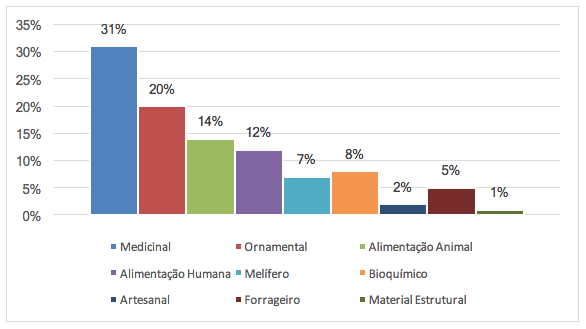
Figure 1. Distribution of species that belong to Mixed Rain Forest by categories of use,
that makes up the 250 species of non-timber use identified. Source: Authors.
Among the 250 species identified non-timber use, approximately 31% had medicinal use and 20% ornamental use. Animal alimentation and for food also stand out with 14% and 12% respectively of the identified species.
About the identified species of MRF, 23% have only one non-timber use and 31% have more than one use, among these, the example is Allophylus edulis (St. Hill.) Radlk. (Sapindaceae) known as Vacum. This species is indicated, for example in food and fodder, as a medicinal plant, biochemical usage, forage and its flowers are honey producers. It is also used in the afforestation of streets and squares (ornamental).
Figure 2 below shows the number of species per botanical family, which can be used for food.
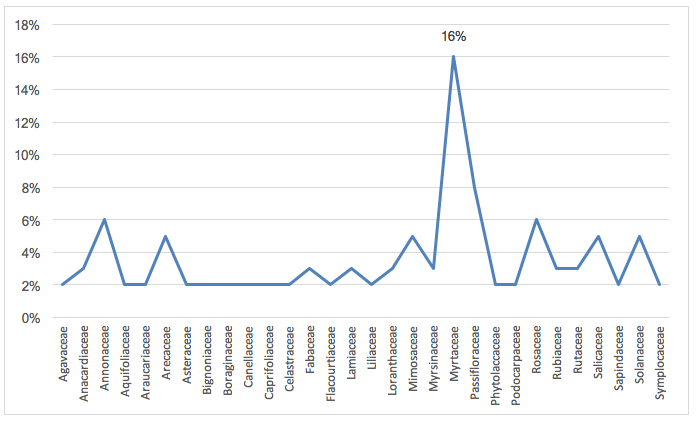
Figure 2. Number of species used for human consumption, sorted by botanical family.
There are approximately 64 species of the MRF with use in human food, totalizing 30 botanical families. Through the graph XX it can be seen that stands out in this category the Myrtaceae family with 10 species, equivalent to approximately 16% of the total amount. The graph XX shows the number of species by botanical family, with utility for feed animals.
Figure 3 shows the number of species per botanical family, which can be used for animal food.
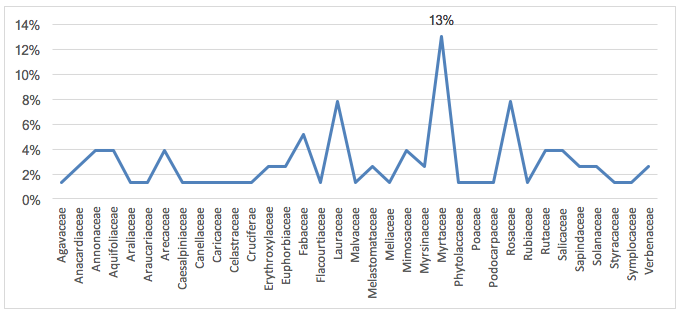
Figure 3. Number of species used for animal feed, by botanical family.
Analyzing the Figure 3, the distribution of 77 forest species of MRF with possibility of use in animal feed, within 35 botanical families.
It can be highlighted from Figures 2 and 3 that the Myrtaceae family groups the largest number of species in each category. The main species used for both food and fodder are: Campomanesia guaviroba (DC.) Kiaersk. (Guabiroba) Campomanesia xanthocarpa O. Berg. (Guabiroba), Myrciaria cauliflora DC. (Jaboticaba), Eugenia involucrata DC (Cherry), Eugenia uniflora (Pitanga) Myrciaria tenella (DC.) Berg. (Cambui) and Psidium cattleianum Sabine (Araçá).
A The Figure 4 shows the number of species by botanical family, used as medicinal plants.
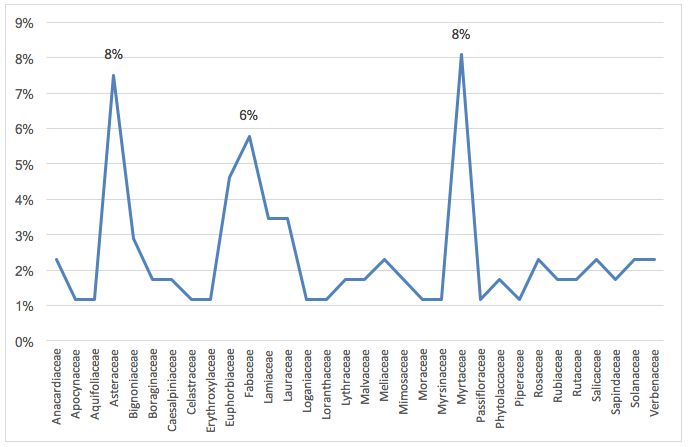
Figure 4. Number of species uses as medicinal plants
This category stands out for having the largest number of families and species among the categories of NTFPs described. There are approximately 173 species of MRF with used as therapeutic or medicinal plants, part of 71 families. Among the most representative families in terms of number of species suitable for medicinal use are the Myrtaceae, Asteraceae and Fabaceae.
Figure 5 shows the number of species by botanical family, suitable for ornamental purposes.
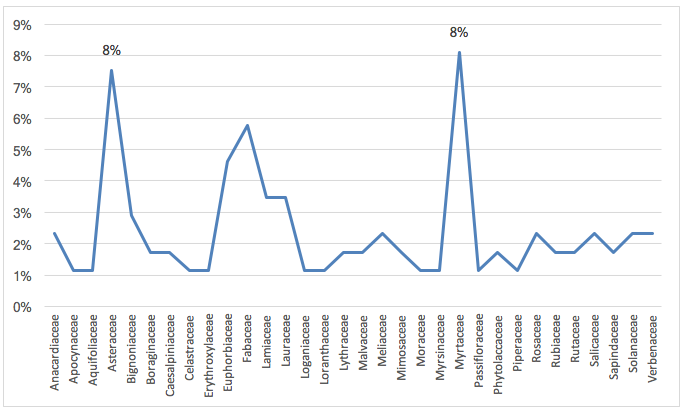
Figure 5. Number of species used for ornamental purposes by botanical family greater than 1%.
This category is the second highest number of species and plant families. The 113 species belongs to 50 botanical families. It stands out in this category of use of the Myrtaceae and Bignoniaceae families, and Mosiera prismatica species (D. Legrand) Landrum (Ironwood) and Jacaranda puberula (Caroba).
Figure 6 shows the number of species by botanical family, suitable for honey production.
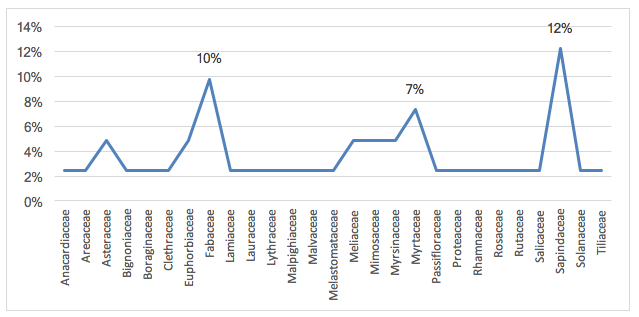
Figure 6. Number of species used as honey producers by botanical family.
It is observed in Figure 6, that the distribution family of 41 species suitable for the production of honey. These species belong to 27 families, which stand out in number of species of Sapindaceae and Fabaceae families, the first being the most representative within the group. Among the species that make up the Sapindaceae family stand out Allophylus edulis (St. Hill.) Radlk. (Vacum), Matayba elaeagnoides Radlk. (Miguel-pintado) and Paullinia carpopodea Cambess. (Timbó).
Figure 7 shows the number of species by botanical family, suitable for biochemical use (oils, resins, grease, latex).
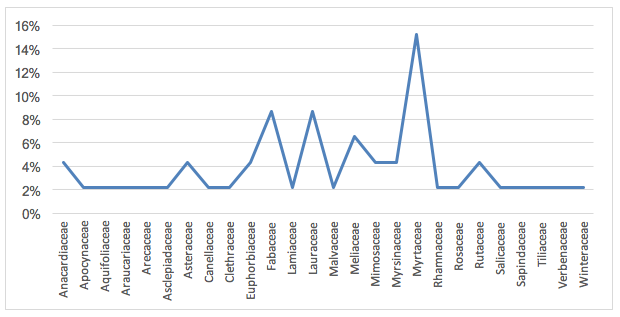
Figure 7. Number of species used for biochemistry by botanical family.
Observing the Figure 7, note the distribution of 46 species of MRF indicated for biochemical use, belonging to 26 botanical families. The Myrtaceae family stands out with 15.22% of the species identified for this purpose. Among the species are: Blepharocalix salicifolius (H.B.K.) Berg. (Myrtle), Calyptranthes concinna DC. (Guamirim), Campomanesia xanthocarpa O. Berg. (Guabiroba), Eugenia uniflora (Pitanga), Eugenia uruguayensis Cambess. (Batinga), Myrceugenia euosma (O. Berg) D. Legrand (Guamirim-do-branco), Myrcianthes gigantea (Guava-do-mato) D. Legrand.
Figure 8 below shows the number of species by botanical family, indicated for the craft uses, structural and forage material. After that, Figure 9 shows in terms of fodder destination plants.
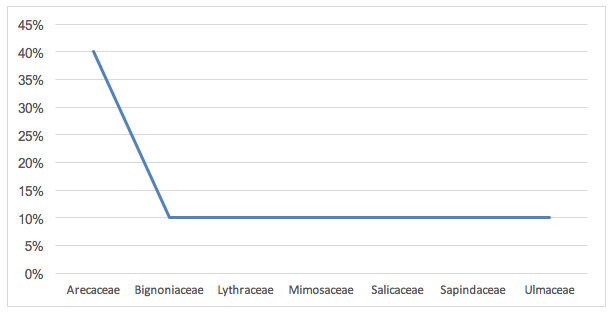
Figure 8. Number of species used in the category: handicraft
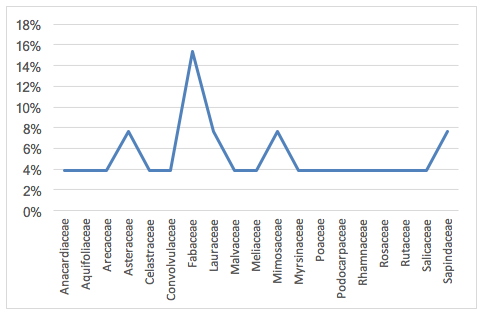
Figure 9. Number of species used in the category: fodder.
Analyzing Figures 8 and 9 it is observed that there are about 10 species from MRF were indicated in the literature for handicraft. These species belong to 7 botanical families. In this category of use there is the Arecaceae family with 4 species suitable for this purpose. They are: Bactris lindmanniana Ducke ex Lindm. (Tucum), Butia eriosphata (Mart. Ex Drude) Becc (Butiá), Euterpe edulis Mart. (Juçara) Geonoma schottiana Mart. (Guaricana). Indicated for the category of forage use 26 species appears belonging to 19 families, with emphasis on the Fabaceae family, with 15.38% of the species listed for that purpose. The use as a structural material was the least observed between the usage categories of NTFPs in Mixed Rain Forests, with only 6 species belonging to 6 families (approximately 17% for each one). Among the species for this purpose are Cordyline dracaenoides Kunth. (Uvarana), Ilex paraguariensis St. Hi. (Herb mate), Araucaria angustifolia (Bertoloni) Otto Kuntze (Araucaria), Geonoma schottiana Mart. (Guaricana) Amburana cearensis (Cumaru), Sida carpinifolia L. (Vassoura).
In the analysis of the nine categories of use in this article, the Myrtaceae family presented significant number of species on five categories: food, fodder, medicine, ornamental and biochemical use. These results indicate the importance of the species of this botanical family for non-timber uses.
Among the species with multiple use, stood out as the most effective: Schinus terebinthifolius Raddi, Ilex paraguariensis St. Hi, Syagrus romanzoffiana (. Cham) Glassman, Zanthoxylum rhoifolium (Lam E.), Allophyllus edulis (St. Hill.) Radlk, that showed the largest number of uses, according to summary of references.
The species of Myrtaceae botanical family presented the most significant results of all families found, and is representative in five of the nine specific categories of use, with large numbers of species with potential use as non-timber products;
The large number of species with multiple uses indicates the value this forest has, expanding the range of possible products to be exploited sustainably;
The medicinal use, a category that involved greater number of species and plant families, is one of the categories of NTFPs that has highest added value, according to FAO data, and demonstrates the unexploited economic potential of using Mixed Rain Forest as an income source for traditional populations;
The great floristic diversity of Subtropical Mixed Rain Forest in Paraná State, plus the number of species identified for non-timber use (45%), proved the great potential of use of the forest as a source of different products and the need of more researches about this issue.
BACKES, A. Dinâmica do pinheiro-brasileiro. Iheringia, série Botânica, Porto Alegre, n.30, p.49-84, 1983.
BEER, J. H. Subsistence use and Market value of non-timber forest products: The example from Southeast Asia. In: Netherlands Committee for IUCN. 1996. 9 - 11.
BLUM, C.; OLIVEIRA, R. Reserva florestal Legal no Paraná, alternativas de recuperação e utilização sustentável, 2005. Disponível em: <www.biodiversidade.rs.gov.br/arquivos>. Acesso em 12 Dez 2010.
CAMPBELL, J. Y. & TEWARI, D. D. Increased development of non-timber forest products in India: some issues and concerns. 1996. In: Unasylva, 47(187): 26-31.
CARVALHO P. E. R. Espécies Arbóreas Brasileiras. Brasília: Embrapa Informação Tecnológica: Colombo, PR: Embrapa Florestas, 2003. Vol. 1.
CARVALHO P. E. R. Espécies Arbóreas Brasileiras. Brasília: Embrapa Informação Tecnológica: Colombo, PR: Embrapa Florestas, 2006. Vol. 3.
CASTELLA, P.R. & BRITEZ, R.M. 2004. A floresta com araucária no Paraná: conservação e diagnóstico dos remanescentes florestais. Fundação de Pesquisas Florestais do Paraná, Ministério do Meio Ambiente, Brasília.
CORDEIRO, J. Levantamento florístico de caracterização fitossociológica de remanescente de Floresta Ombrófila mista em Guarapuava, PR. Curitiba: UFPR, 2005. Tese (Doutorado). Universidade Federal do Paraná, 2005.
FOOD AND AGRICULTURAL ORGANIZATION OF THE UNITED NATIONS - FAO. Allophylus edulis, Daphnopsis racemosa, Erythrina crista-gallii, Eugenia uruguayensis, Guettarda uruguensis, Luehea divaricata, Maytenus ilicifolia, Myrceugenia glaucescens, Parapiptadenia rigida, Salix humboldtiana, Schinus terebinthifolia, Scutia buxifolia, Sebastiania brasiliensis, Vitex megapotamica. Fuente: Basede Datos, DRFN. Muñoz et. al. , 1993. Disponible em: <http://www.fao.org/docrep >
GIL, A. C. Métodos e técnicas de pesquisa social. 6. ed. São Paulo: Atlas, 2008.
HUECK, K. As florestas da América do Sul. São Paulo: Polígloto, 1972.
ISERNHAGEN, I. A fitossociologia florestal no Paraná e os programas de recuperação de áreas degradadas: uma avaliação. 2001. 134f. Dissertação (Mestrado em Botânica) - Universidade Federal do Paraná, Curitiba, 2001.
KLEIN, R.M. O aspecto dinâmico do pinheiro-brasileiro. Sellowia, Itajaí, v. 12, n. 12, p. 17-48, 1960.
LEITE, P. F. 1994. As diferentes unidades fitoecológicas da região sul do Brasil. Universidade Federal do Paraná, Curitiba, Dissertação (mestrado em Ciências Florestais), 160p.
LEITE, P.F.; KLEIN, R.M. Vegetação. In: IBGE. Geografia do Brasil: Região Sul. Rio de Janeiro, 1990. p. 113-150.
LORENZI, H. Árvores brasileiras: manual de identificacão e cultivo de plantas arbóreas nativas do Brasil. Nova Odessa: Plantarum, 1992. 382 p.
LORENZI, H. Árvores brasileiras: manual de identificação e cultivo de plantas arbóreas do Brasil. vol.1. 4.ed. Nova Odessa: Instituto Plantarum, 2002.
MARQUES, T. P. Recuperação florestal com o uso de não madeiráveis. Curitiba: Secretaria de Estado de Meio Ambiente e Recursos Hídricos do Estado do Paraná, 2009.
MOK, S. T., 1991. Production and promotion of non-wood forest products. In: 10º CONGRÈS FORESTIER MONDIAL, Revue Forestière Française, Hors série nº 6. Anais... Paris: p. 103-111.
RODERJAN, C. V.; GALVÃO, F.; KUNIYOSHI, Y. S.; HATSCHBACH, G. G. As unidades fitogeográficas do Estado do Paraná. Ciência e Ambiente, Santa Maria, n.1, p.75-92, 2002.
SANTOS, A. J.; HILDEBRAND, E.; PACHECO, C. H. P.; PIRES, P. T. L.; ROCHADELLI, R. Produtos não madeireiros: conceituação, classificação, valoração
e mercados. Floresta, v.33, n.2, p.215-224, 2003.
WICKENS, G. E. 1991. Management issues for development of non-timber forest products. In: Unasylva, 42(165): 3-8.
1. Doctor in Forest Sciences, Professor, Department of Agricultural Economics and Extension - Federal University of Paraná - UFPR, Curitiba / PR, Brazil.
2. Forest Engineer, During MSc. in Tropical Forest Sciences, National Institute for Amazonian Research - INPA, Manaus / AM, Brazil
3. PhD student in Forest Engineering, Department of Agricultural Economics and Extension - Federal University of Paraná - UFPR, Curitiba / PR, Brazil
4. PhD student in Forest Engineering, Department of Agricultural Economics and Extension - Federal University of Paraná - UFPR, Curitiba / PR, Brazil. email: davidburatto@yahoo.com.br
5. Environmental Project Consultant at Cia Ambiental, Forest Engineer, Federal University of Paraná - UFPR, Curitiba / PR, Brazil